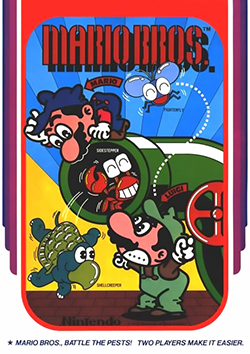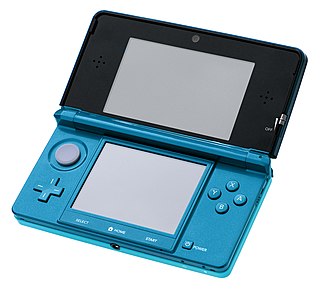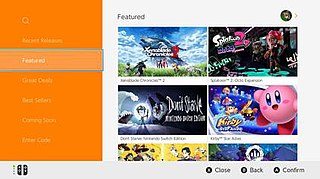
Nintendo Co., Ltd. is a Japanese multinational video game company headquartered in Kyoto. It develops, publishes and releases both video games and video game consoles.

Mario Bros. is a platform game developed and published by Nintendo as an arcade video game in 1983. It was designed by Shigeru Miyamoto and Gunpei Yokoi, Nintendo's chief engineer. Italian twin brother plumbers Mario and Luigi exterminate creatures, like turtles (Koopas) and crabs emerging from the sewers by knocking them upside-down and kicking them away. The Famicom/Nintendo Entertainment System version is the first game produced by Intelligent Systems. It is part of the Mario franchise, but originally began as a spin-off from the Donkey Kong series.

Balloon Fight is an action video game developed by Nintendo and HAL Laboratory and published by Nintendo. The original arcade version was released for the Nintendo VS. System internationally as Vs. Balloon Fight, while its Nintendo Entertainment System counterpart was released in Japan in 1985 and internationally in 1986.

Nintendo Selects is a marketing label previously used by Nintendo to promote best-selling video games on Nintendo game consoles. Nintendo Selects titles were sold at a lower price point than new releases. The program paralleled other budget range software by Sega, Sony, and Microsoft to promote best-selling games on their consoles as well. In Japan, the discount label was introduced in 2015 for various Nintendo 3DS titles as the Happy Price Selection, although South Korea adopted the Nintendo Selects name at an earlier period. The most recent Nintendo Selects titles were released for the Wii U and 3DS and, as of January 2024, no Nintendo Switch games have been rebranded as Nintendo Selects.
Homebrew, when applied to video games, refers to software produced by hobbyists for proprietary video game consoles which are not intended to be user-programmable. The official documentation is often only available to licensed developers, and these systems may use storage formats that make distribution difficult, such as ROM cartridges or encrypted CD-ROMs. Many consoles have hardware restrictions to prevent unauthorized development.
The Virtual Console is a defunct line of downloadable video games for Nintendo's Wii and Wii U home video game consoles and the Nintendo 3DS family of systems.
WayForward Technologies, Inc. is an American independent video game developer and publisher based in Valencia, California. Founded in March 1990 by technology entrepreneur Voldi Way, WayForward started by developing games for consoles such as the Super NES and Sega Genesis, as well as TV games and PC educational software. In 1997, they relaunched their video games arm, placing the company as a contractor for publishers and working on a variety of licensed assets.
Arika is a Japanese video game developer and publisher. It was formed in 1995 by former Capcom employees. It was originally known as ARMtech K.K, but was later named Arika. The name of the company is the reverse of the name of the company's founder, Akira Nishitani, who along with Akira Yasuda, created Street Fighter II. Arika's first game was Street Fighter EX. It was successful and was followed up with two updates, and its two sequels Street Fighter EX2 and Street Fighter EX3. In 2018, they released a spiritual successor to both Street Fighter EX and Fighting Layer, titled Fighting EX Layer. From 2019 to 2021, Arika collaborated with Nintendo to create the battle royale games Tetris 99, Super Mario Bros. 35, and with Bandai Namco for Pac-Man 99. Arika is also known for the Tetris: The Grand Master series, the Dr. Mario series, starting with Dr. Mario Online Rx, and the Endless Ocean series.

The history of Nintendo is from 1889 to the present, starting as a playing-card company to eventually becoming a multinational video game conglomerate. It has always remained headquartered in Kyoto, Japan.

The Mysterious Murasame Castle is an action-adventure video game developed by Nintendo and Human Entertainment and published by Nintendo for the Family Computer Disk System. It was released exclusively in Japan on April 14, 1986. The game was one of the early games released for the system, and the second original game after The Legend of Zelda. The game was released outside Japan for the first time on the Nintendo 3DS Virtual Console in Europe and Australia in May 2014 and in North America in August 2014. It was added to the Nintendo Switch Online service on October 31, 2023.

The Japanese multinational consumer electronics company Nintendo has developed seven home video game consoles and multiple portable consoles for use with external media, as well as dedicated consoles and other hardware for their consoles. As of September 30, 2021, in addition to Nintendo Switch, Nintendo has sold over 863.07 million hardware units.

A video game console emulator is a type of emulator that allows a computing device to emulate a video game console's hardware and play its games on the emulating platform. More often than not, emulators carry additional features that surpass limitations of the original hardware, such as broader controller compatibility, timescale control, easier access to memory modifications, and unlocking of gameplay features. Emulators are also a useful tool in the development process of homebrew demos and the creation of new games for older, discontinued, or rare consoles.

Mario is a Japanese multimedia franchise created by Japanese game designer Shigeru Miyamoto for video game company Nintendo, which produces and publishes its installments. Starring the titular Italian plumber Mario, it is primarily a video game franchise but has extended to other forms of media, including television series, comic books, a 1993 feature film, a 2023 animated film, and theme park attractions. The series' first installment was 1983's Mario Bros., although Mario made his first appearance in 1981's arcade game Donkey Kong and had already been featured in several games of the Donkey Kong and Game & Watch series. The Mario games have been developed by a wide variety of developers, including Nintendo, Hudson Soft, and AlphaDream. Mario games have been released almost exclusively for Nintendo's various video game consoles and handhelds, from the third generation onward.

The Nintendo 3DS is a foldable handheld game console produced by Nintendo. The console was announced in March 2010 and unveiled at E3 2010 as the successor to the Nintendo DS. The system features backward compatibility with Nintendo DS video games. As an eighth-generation console, its primary competitor was Sony's PlayStation Vita.

The Nintendo eShop is a digital distribution service for the Nintendo Switch, and formerly available via the Nintendo Network for the Wii U and Nintendo 3DS. The Nintendo eShop was first launched in June 2011 on the Nintendo 3DS via a system update that added the functionality to the HOME Menu. It is the successor to both the Wii Shop Channel and DSi Shop. Unlike on the Nintendo 3DS, the eShop was made available on the launch date of the Wii U, although a system update is required in order to access it. It is also a multitasking application, which means it is easily accessible even when a game is already running in the background through the system software, though this feature is exclusive to the Wii U and the Nintendo Switch. The Nintendo eShop features downloadable games, demos, applications, streaming videos, consumer rating feedback, and other information on upcoming game releases.

Majesco Entertainment Company is an American video game publisher and distributor based in Hazlet, New Jersey. The company was founded as Majesco Sales in Edison, New Jersey in 1986, and was a privately held company until acquiring operation-less company ConnectivCorp in a reverse merger takeover, becoming its subsidiary and thus a public company on December 5, 2003. ConnectivCorp later changed its name to Majesco Holdings Inc. on April 13, 2004.
The Nintendo data leak, also known as the Nintendo Gigaleak, is a series of leaks of data from the Japanese video game company Nintendo on the anonymous imageboard website 4chan. The leak started in March 2018, but became most prominent in 2020. Ten main sets of data leaked on 4chan, ranging from game and console source code to internal documentation and development tools. The name "Gigaleak" mainly refers to the second leak on July 24, 2020, which was 3 gigabytes in size. The leaks are believed to have come from companies contracted by Nintendo in the design of these consoles, and/or from individuals previously convicted of intrusion into Nintendo systems. An earlier, much smaller leak had also occurred in 2018 which contained the Nintendo Space World 1997 demos for Pokémon Gold and Silver.













